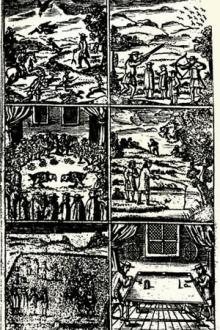The School of Recreation, Robert Howlett [general ebook reader .TXT] 📗

- Author: Robert Howlett
- Performer: -
Book online «The School of Recreation, Robert Howlett [general ebook reader .TXT] 📗». Author Robert Howlett
Lesson 3. Of giving in the Thrust.
To Thrust or make an Elong, observe (when you stand to your Guard, and your Adversary be within your Measure) that your Sword be as you please, either within or without your Adversaries Sword, and suppose within, then stretch out your Right-arm, and Step forward with your Right-foot as far as may be, keeping the Point strait forwards, and let the Motion of your Arm begin a thought before you move your Foot, so that the Thrust may be given home before your Adversary can hear your Foot touch the Ground; and when you are at your full stretch, keep your Left-hand stretched, and ever observe to keep a close Left-foot, which must be done by keeping your Left-heel and broad side of your Foot close to the Ground, without any drawing it after you, for keeping a close Foot is one of the chiefest things to be observed in this Science. When you give in your Thrust throw your Left-hand behind you, or so place it on your Left-side, that your Sword and both your Arms may make a strait Line from your Adversary. This must be when you design not to make use of your Left-hand for a Parade, but if you do, then in the very time of giving in your Thrust, throw your Left-arm forward as far as you can, without putting the rest of your Body into disorder, turning the Palm from you, by turning your Thumb down, and your little Fingers up, and so Parie your Adversaries Thrust, if you find he will Thrust, upon the same time you make your Thrust, always remembring when you Thrust within the Sword, to do it with your Nails in Quart or upwards, and Quart well your Hand and Shoulder; but when a Thrust is made without the Sword, then give it in with your Nails in Terce or downwards, and keep your Hilt much lower than your Point, and your Head as clear as may be from you Adversaries Sword.
Take notice in all Lessons in which you do not first secure or bind your Adversaries Sword, that you are to Thrust close by the Feeble of his Sword, with the Fort of yours. But there is a difference when you first secure your Adversaries Sword, for after your securing or binding, you quit his Sword, and give a strait home Thrust, without touching it, after it is bound.
In these Rules there is great advantage, as in the Quarting of your Hand, when you Thrust within, the Sword, preserves them from your Adversaries Counter-Temps Thrusts in the Face; so likewise does your Thrusting close by the Feeble of the Sword, and keeping your Hilt lower than the Point, when you Thrust without the Sword, as also the holding of your Head to the contrary side your Adversaries Sword is on, preserve you from Counter-Temps, ever observing as a general Rule; to keep your Head on the contrary side of your Adversaries Sword, on what side soever you Thrust, for this will frequently preserve your Face from being hit.
Lesson 4. Of Caveating or Disengaging.
In this case, when your Sword is presented within your Adversaries Sword, and you would have it without (keeping your Nails in Quart) slope your Point so low that you may bring it up under the out-side of his. This must be done with the Wrist, and not any Motion of the Arm, because when you Disengage, if the Arm move, your body would be too much discovered; so that your Adversary would have an advantage to give in his Thrust, which he could not do if only your Wrist moved, and this must be done with a sudden Motion; and by this you may learn to slip your Adversaries Sword at pleasure.
Lesson 5. Feinting or Falsifying
Of these, there are several kinds, and the first retreat on is the Ordinary single Feint; When you are on your Guard, and within your Adversaries Sword, disengage and make your Feint without, which you must do with a beat of your Right-foot against the Ground, just as you disengage, and your Sword on the out-side of your Adversaries, and immediately after, if you perceive him answer your Feint, and offer to Parie, disengage again, and give him the Thrust within the Sword.
Lesson 6. The Double Feint.
There is a difference between this and the single Feint; for in the single one you must make two Motions, viz. With the first you make your Feint, and with the next you give in your Thrust, unless you make your Feint on that side your Sword lyeth, which may be done without disengaging, and is the simplest of all others in all single Feints, it must be given in upon the side your Sword was before you made your Feint; But in the double Feint you are to make three Motions, and the Thrust (unless when you make your first Motion on that side your Sword was presented) is given in on the other side, and not on the side the Sword was just before you began to make your Feint; and to play this, there are two ways, viz. When you are within Measure, you must play it one way, and without Measure another way.
As to the first, your Sword being presented within your Adversaries Sword, then disengage and make your first Motion without his Sword, to stand a Thought on it to try whether he will answer you, by offering to proceed to the Parade; if he do not answer, it is useless, but if he do, then presently make your second Motion within his Sword, and your third Motion without it, by giving the Thrust; both these Motions must be done with admirable quickness; at every Motion give a beat with your Foot, and disengage; turning your Nails in Quart.
If you are without distance, make a Motion to see if he will answer your Feint, and if he do begin again, make your first Motion, as within distance, approaching at the same time, and so your second and third.
There is a contrary to these, that is to be observed when your Adversary makes use of them against you, Then you must make use either of the Counter-caveating Parade, or keep your Sword Point immoveable towards his Face that opposes you, your Arm as much stretched out as possible; and when you do so you must recover your Body, by drawing your Right foot close to your Left, stand as it were on Tip-toe, and if for all this your Adversary give a home Thrust, then you must Counter-temps him in the Face, and Parie his Thrust with your Left-hand; or if you perceive him make variety of Feints, then upon every one of them make a half Thrust, which will oblige him to betake himself to the Parade, and so when you please you may take the pursuit, or when he makes variety of Feints, give a plain home Thrust, as smart as may be, and endeavour to defend your self from Counter-temps with your Left-hand, and to prevent them, it is always in this Case best when you give a Thrust, to use your Left-hand.
Lesson 7. The Single Feint at the Head.
Being within distance you may present your Sword within or without your Opponents Sword, making a Feint or Motion at his Face, if your Sword be presented without, by a little stretching out your Right-Arm, your Nails in Quart, and when you make the Motion, give a little beat with your Right-foot, and if the Feint be answered, then immediately give in your Thrust at his Arm-pit your Head under your Sword-arm, your Left-hand held before you, with the Palm of it looking towards your Right-side, and that part of your Arm, from the Points of your Fingers to your Elbow, must stand in a manner strait upwards, which posture you must ever observe when you give in this Thrust, because in doing it, it defends you from the Thrust of your Adversary, if it be above, and without your Sword; and you may at the same time make a Motion at his Face.
Lesson 8. Of the double Feint at the Head.
Being within distance, make your first Motion or Feint, as before, at the Face, your second Motion low without your Adversaries Sword, towards his belly; and with the third, give a Thrust without, and above his Sword, your Nails in Quart, marking every motion with your Head, Hands and Feet; and when you make your second Motion, hold your Hand as in the single Feint, and when you give in your Thrust above Sword, you must Quart your Head well, because you must give it in with your Nails in Quart; and by this means your Body will be kept secure within your Sword, when in Terce it would ly open, especially to Counter-temps.
There is a Parying the contrary, either with the Counter-caveating Parade, or by answering every Motion, by what means you will fall to Parie your Adversaries with the first Parade in Terce.
Lesson 9. Containing the manner of the Feint at the Head on the True Parade.
The contrary to the second Parade is this, and to do it you must make your Motion at your Adversaries Face, and if you imagine he intends to Parie you with the second Counter-caveating Parade, make round his Sword, as it were going a circle about it, and so give a Thrust at his Arm-pit, and with your Left-hand avoid Counter-temps, and being within distance, approach with your first Motion, and in so doing you Caveat his Sword and shun his Parade, or if your Adversary follows your Sword, you may make two or three circles till you find a fit time to let in your Thrust.
Lesson 10. Of the Low Feint.
When you intend to proceed in this, you must have your Sword without your Adversaries and when it is so, make directly the Second Motion of the double Feint at the Head, and give in the Thrust above, and when you are without distance, make your approach with the Feint, or first Motion; and make in your Thrust with the second. And this may be Paryed, by answering every Motion, or using the Counter-caveating Parade.
The contrary to it, is, when your Adversary is making his low Feint, to take time, and give in the Thrust above his Sword, your Nails in Quart.
Lesson 11. Of Battery.
This is a kind of a Beat from whence it derives its name, and therefore when you play it you must present your Sword either without or within your Adversaries, if within, and he within your Measure, then keep your Sword half a Foot from his, and when you intend to play, Strike a small stroak on the Edg, and Feeble of your Sword on the Edg, and Feeble of his, and at the same Moment give a Beat with your Foot, which will surprize your Adversary, if not well skilled; if it does not, nor that he answers you by offering to Parie, give a strait home Thrust at his Right-Pap, as you give in a plain Thrust within the Sword, moving the Sword only with your Wrist, and thereby keeping your Body close. If your Adversary offers to answer your stroak, and go to the Parade, then your best way is to slip him, and give in a Thrust without, and above





Comments (0)